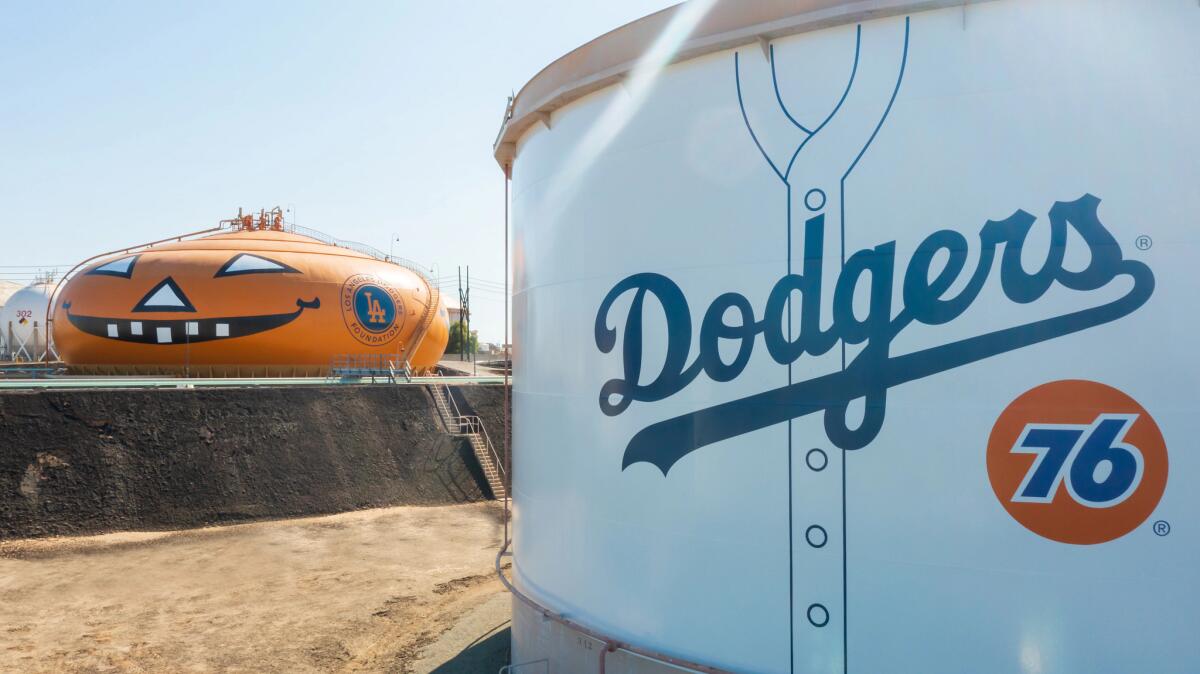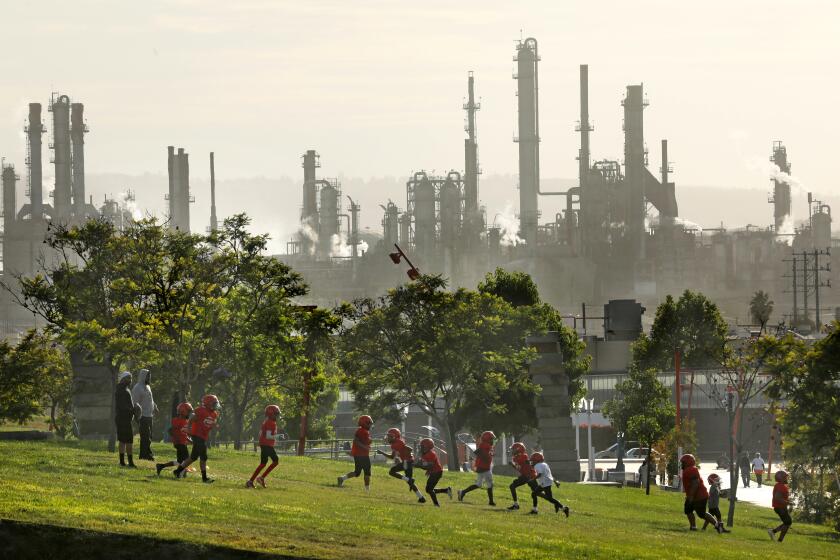Potentially the last smile from Wilmington-area refinery’s jack-o’-lantern storage tank

- Share via
In a sea of gray, white and beige storage tanks within the Phillips 66 oil refinery complex in the city of Wilmington, one stands out from the rest with its orange body and toothy grin.
Every October since 1952, a 3-million-gallon oval storage tank has been transformed into “the world’s largest jack-o’-lantern,” according to Al Ortiz, spokesperson for Phillips 66. Known as Smilin’ Jack, the tank was once used to store gasoline but now is just in reserve.
It takes more than 100 gallons of paint to prepare Jack for his “grand appearance,” Ortiz said, including eyes that are 18 feet high, a grin that’s 73 feet wide and teeth that are 4 square feet in size. As monumental a task as that may be, it used to require significantly more paint; in 1956, The Times reported that it took 180 gallons of paint to make Jack the perfect shade of orange and provide his distinctive facial features.
In October, though, Phillips 66 announced it will shutter the complex toward the end of next year.
With the imminent closure of the refinery, who will be in charge of bringing Smilin’ Jack to life is unknown.
“The future of Smilin’ Jack is still being discussed, and Phillips 66 will keep the community informed,” Ortiz said.
Phillips 66 announced Wednesday that it will close its Wilmington-area refinery complex next year but will work with the state to continue supplying fuel to consumers.
The tank’s distinctive squat and oval shape reflects its original purpose, which was to store substances that “will not remain in liquid form unless held under slight pressure or for light oils that vaporize readily,” wrote Nicholas Beyelia, a librarian for the Los Angeles Public library.
This shape enables the tank to withstand a greater amount of pressure than a cylindrical tank can, Beyelia said.
In his research, Beyelia found that the primer used to prep the tank when it was completed in October 1952 had an orange tint.
“The proximity to Halloween as well as the shape and initial color of the tank’s primer drew inevitable comparisons to a pumpkin by Union Oil staff,” he said.
It’s unclear who suggested painting the face on the tank. There are many competing stories for how the tradition started, Ortiz said.
Some said the idea was thought up by an employee, while others say it came from a plant executive.
The decision by Phillips 66 this week to shutter its refinery in Wilmington next year will wipe out more than 8% of the state’s crude oil processing capacity.
A 1997 article in The Times points to Paul Doyle, a refinery maintenance worker who thought it would be great to paint the tank to “look like an overgrown vegetable from a pumpkin patch.”
Beyelia, however, said Doyle was a plant executive and resident of Rolling Hills Estates.
That grin originally was directed toward the Rolling Hills community, Beyelia said, but once the Harbor Freeway was completed, painters moved the face so it could be seen by southbound motorists. This caused a flurry of complaints from Rolling Hills residents. In an effort to expand the reach of Jack’s smile and placate the community, painters created a jack-o’-lantern face on both sides of the tank, he said.

Community is in large part the focus of Smilin’ Jack. A part of the draw to the oversized pumpkin is that during one day every October, families are allowed to come in by car and see him up close.
There isn’t a record of the exact date or year that the refinery opened its doors to the public for a Jack viewing. But the first public invitation by the refinery was published in 1964 by the Los Angeles Herald-Examiner, according to Beyelia.
Each year the attraction brings in about 20,000 visitors, who leave smiling too with a free bag of caramel popcorn, Ortiz said.
“The event brings families together to celebrate, complete with the famous caramel corn, and has become a long-standing part of the local community,” he said.
While the refinery is a sizable employer, with about 600 employees and 300 contractors operating the site, there have been complaints in recent years of acrid odors, soot and harmful emissions. Phillips 66 also is seeing a shift win California’s need for fuel as policy and consumers move toward electric vehicles.
More to Read
Sign up for Essential California
The most important California stories and recommendations in your inbox every morning.
You may occasionally receive promotional content from the Los Angeles Times.













